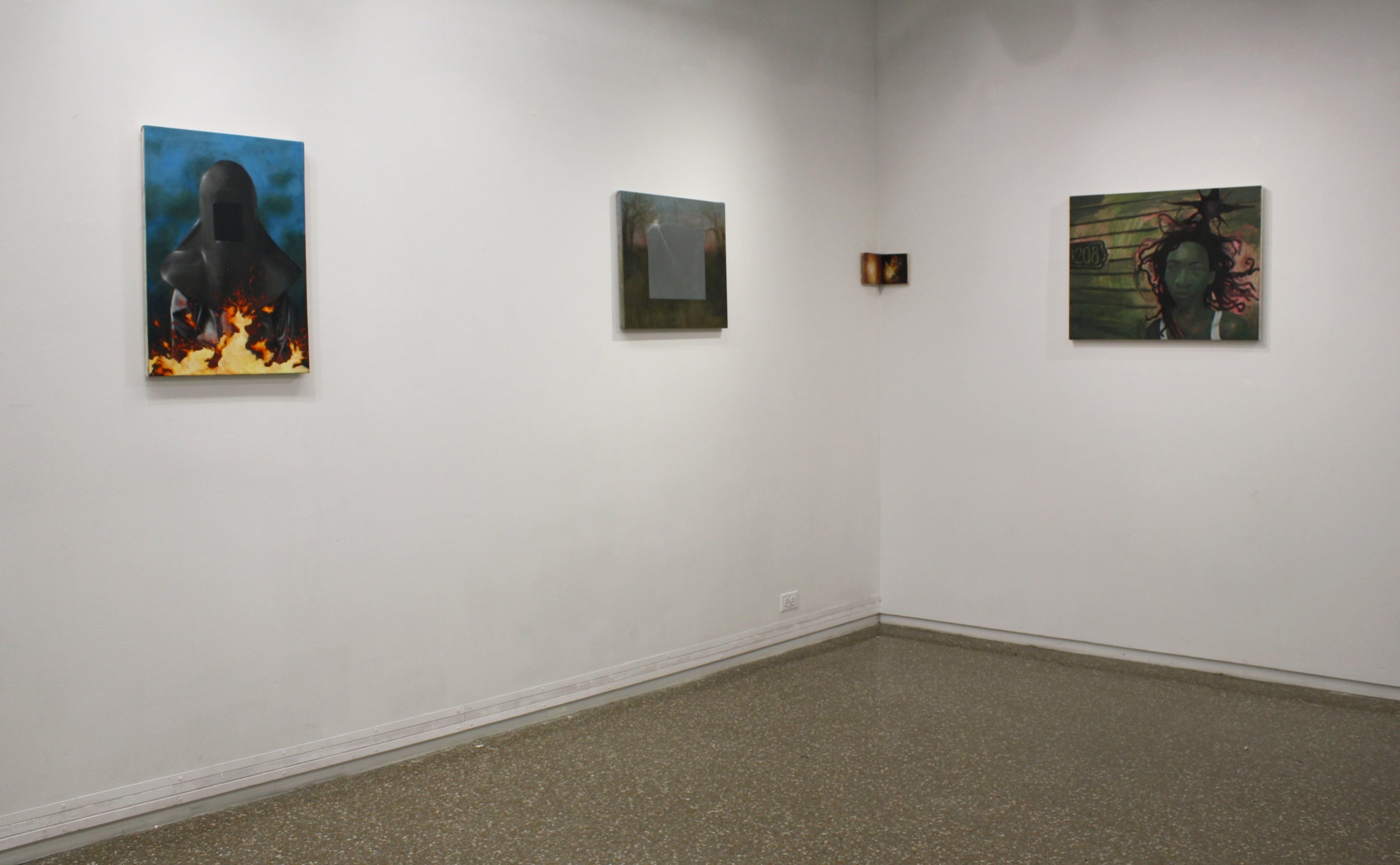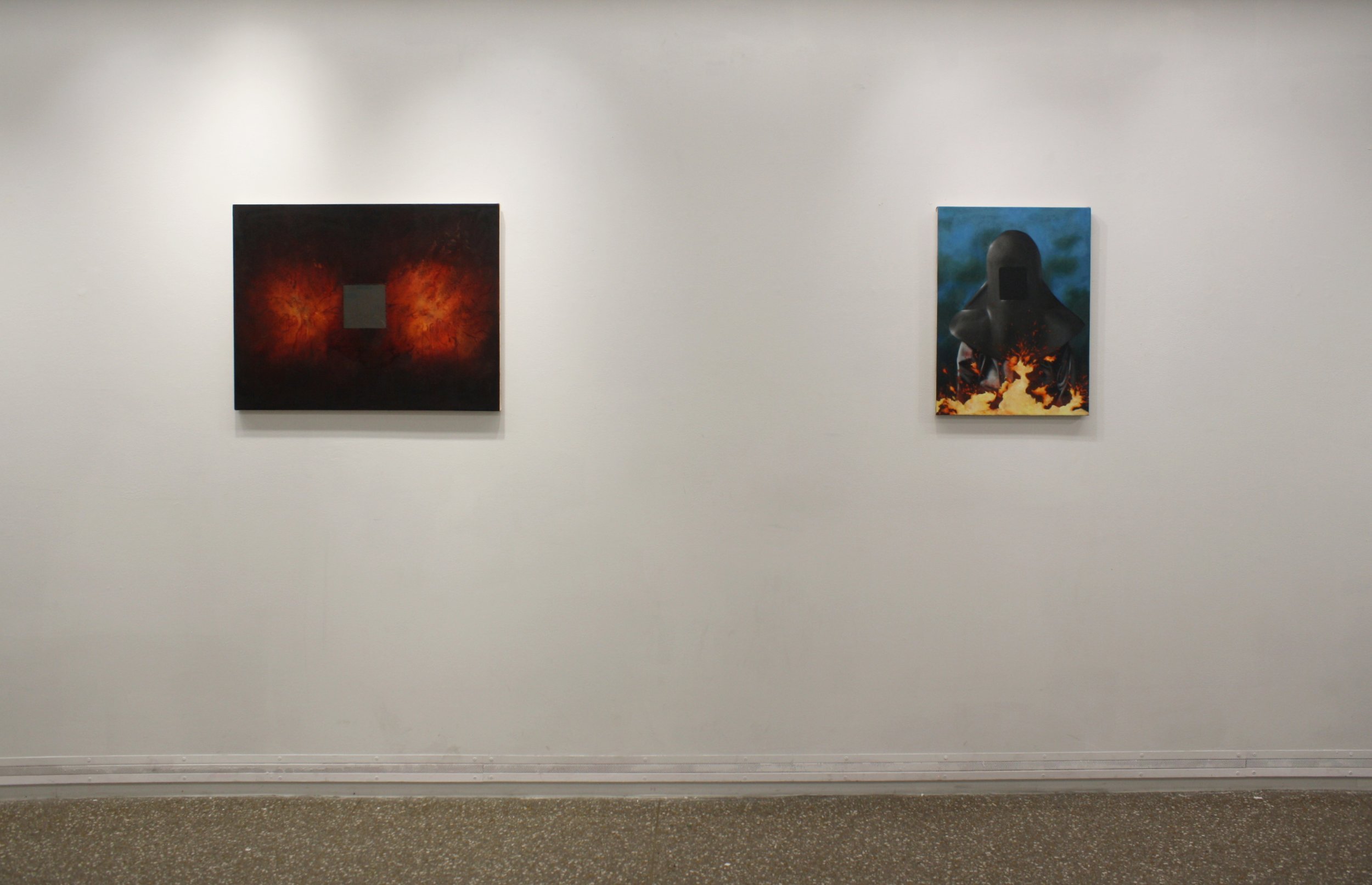An Interview with Audrey Clarendon: Depersonalization/Derealization Disorder Through Art
Theo Faugeres - February 16, 2024
Depersonalization/derealization disorder (DPDR) stands as an often misunderstood and underexplored mental health condition, a scarcity impacting both those who have experienced it and those striving to better understand and approach it in clinical settings. Audrey Clarendon is a sophomore majoring in physics and astronomy at Northwestern University and artist who has previously done work in painting and photography, as well as someone who has experienced DPDR in the past. Over the summer of 2023, Clarendon’s Summer Undergraduate Research Grant (SURG) -funded exploration of the experience of DPDR and its potential expressions on canvas culminated in her Depersonalization Series.
Depersonalization/Derealization disorder, as yet a poorly understood psychological phenomenon, is intricately tied with dissociation, a disruption in the integrated functions of consciousness, memory, identity, and perception. The disorder manifests without clinically notable memory or identity disturbances, and its onset typically occurs around the age of 16. Depersonalization, a specific type of dissociation, involves a disrupted integration of self-perceptions with the sense of self. Individuals experiencing depersonalization feel estranged, detached, or disconnected from their own being. Common depersonalization experiences include watching oneself from a distance, out-of-body experiences, feeling like one is in a dream, and detachment from body parts or the whole body. Depersonalization often coexists with derealization, a sense of unfamiliarity or detachment from one's surroundings. Worded in less technical but more evocative ways, Clarendon’s own interviewees (part of her project, as we will see below) described the experience of DPDR “as if I’m sitting inside very thick glass” or “as if I’m still me but moved three inches to the right.” While short-lived experiences of depersonalization are prevalent in the general population, persistent or recurrent depersonalization requires consideration of DPDR.
Abducted in plain sight (Le coup de vide)
Audrey Clarendon's engagement with art is a long standing personal pursuit. A classmate’s commission led her to portraiture and oil painting. While the artist has not taken extensive formal classes, a painting class in Winter 2023 became a turning point, and eventually led to her exhibition at Norris’ Dittmar Memorial Gallery in March 2023, titled “When Homeward You Turn.”
As the veil lifts (What once was is no more) - on the shadowy and mystical existential feelings experienced by some DDD afflicted
Differentiation and disintegration diptych (A summary)
Detail
Clarendon’s recent project comes after the artist’s bout with DPDR in December of 2022 pushed her into looking for a way to express and understand her own experience. As such, the central question the artist sought to answer with her project was: how can DPDR be translated through existing as well as original artworks? This worked as complementary with the larger goal of bridging the knowledge gap surrounding DPDR, recognizing the difficulty in translating the feeling or essence of the disorder between those who suffer from it, those who do not, and healthcare professionals. She aimed to create an accessible library of work that not only reflected the direct experience of DPDR but also hoped to improve both formal and informal understanding of the disorder.
Over the summer, the project unfolded as originally planned, with weekdays dedicated to working at the art studio in Kresge Hall, with interviews and conversations with persons of interest interspersed over the summer. Clarendon interviewed seven people who have had past experience with DPDR and two health professionals - Ben Meijer and Dr. Daphne Simeon. Coming into these interviews with some materials prepared, such as an image-based survey asking interviewees whether their lived experiences felt linked to works by a variety of artists, over the course of the process Clarendon was able develop this approach further as well as discover others. The survey gained new images and artists, and the need for more nuanced questions led her to employ powerful tools such as "as if" statements and compile a larger body of scholarly literature (including articles and especially Feeling Unreal, a book by Dr. Simeon and Jeff Abugel that is a touchstone to DPDR research today) to better engage the experiences of interviewees.
Through the eyelids (Participant vs. Observer) with details below
The end of all things (Empty space) - on the symptom of profound emptiness/nothingness
Beyond Feeling Unreal, Clarendon sought depictions and understandings of the condition in a variety of mediums, whether direct or indirect. The artist broke in the current state of the formal/medical understanding of DPDR (if such a distinction can be drawn) through preliminary studies and overviews of the conditions. Clarendon also leveraged multimedia works on the topic such as Jake Hart's short film, "Feeling Unreal: A Short Look into the Lives of Depersonalized Persons," (which offers a personal account), as well as compiling a Spotify playlist which (similarly to the image survey mentioned above) tapped into the emotions associated with the disorder. In the thread of this latter example, the artist highlighted the idea of the “DPDR-coded” media which made up part of her influence and exploration, including "Nausea" by Jean Paul Sartre, the film "Anomalisa" by Charlie Kaufman, and a podcast episode on liminal spaces. All of these served as both inspiration and backdrop to the artist’s creative process.
Under this dark star (With hairs on end)
Detail
Volcanologist’s Folly (Hypoemotional) with details below - on the symptom of detachment from one’s own feelings called hypoemotionality
On the basis of her initial queries, along with questions arising out of the interviews, the project ultimately resulted in a library of recorded interviews, nine completed paintings of varying sizes, and accompanying notes on DPDR, the latter ranging from personal accounts to a snapshot of DPDR studies in the medical world, identifying trends in onset and the timeline of afflicted individuals. Themes and narrative threads brought into consideration by initial artworks and results served as platforms on which to follow up on in subsequent artworks. One concept in particular, as the artist pointed out, was "le coup de vide" (“the blow of the void”), which tackled the “invasive nothingness” of the depersonalized feeling, which Clarendon integrated into her visual themes by the treatment of space (crowding), faces (obscuring) and color. The importance of making such a feeling “accessible,” returning to the original goal of growing awareness around DPDR, was reinforced by the interviewees’ accounts of the insufficiency and inadequacy of existing healthcare systems globally at providing care for and diagnosing the condition.
After receptivity to her artworks from the original interviewees, the artist’s next steps involve applying to galleries so as to exhibit her works and inform audiences about DPDR. Audrey Clarendon’s work is displayed on the website and blog Artists on the Lam as well as part of a virtual exhibition by the Galley Omnibus.
Please note: this interview has been edited for length and clarity.


![Abducted in plain sight (Le coup de vide) [Detail 1].jpg](https://images.squarespace-cdn.com/content/v1/61774d92afd3c117cdba5d50/1708042354073-M3P3MRUK3XRJ3HUXIGZK/Abducted+in+plain+sight+%28Le+coup+de+vide%29+%5BDetail+1%5D.jpg)
![Abducted in plain sight (Le coup de vide) [Detail 2].jpg](https://images.squarespace-cdn.com/content/v1/61774d92afd3c117cdba5d50/1708042375100-7MK98TG6V1WSSQEER7VR/Abducted+in+plain+sight+%28Le+coup+de+vide%29+%5BDetail+2%5D.jpg)
![Abducted in plain sight (Le coup de vide) [Detail 3].jpg](https://images.squarespace-cdn.com/content/v1/61774d92afd3c117cdba5d50/1708042400350-THRXC915QG5VNKBMBG52/Abducted+in+plain+sight+%28Le+coup+de+vide%29+%5BDetail+3%5D.jpg)
![Abducted in plain sight (Le coup de vide) [Detail 4].jpg](https://images.squarespace-cdn.com/content/v1/61774d92afd3c117cdba5d50/1708042423920-WRITNNNWCI0FOKHC6GP7/Abducted+in+plain+sight+%28Le+coup+de+vide%29+%5BDetail+4%5D.jpg)


![As the veil lifts (What once was is no more) [Detail 1].jpg](https://images.squarespace-cdn.com/content/v1/61774d92afd3c117cdba5d50/1708036815707-3B8XTTO4GUDL8FYR9ZB3/As+the+veil+lifts+%28What+once+was+is+no+more%29+%5BDetail+1%5D.jpg)
![As the veil lifts (What once was is no more) [Detail 1] (1).jpg](https://images.squarespace-cdn.com/content/v1/61774d92afd3c117cdba5d50/1708036835051-ONA3HVPR9KJJSIEX0YGI/As+the+veil+lifts+%28What+once+was+is+no+more%29+%5BDetail+1%5D+%281%29.jpg)




![Through the eyelids (Participant vs. Observer) [Detail 1].jpg](https://images.squarespace-cdn.com/content/v1/61774d92afd3c117cdba5d50/1708037560988-XVNSZFLB5E30ZUXVAOJO/Through+the+eyelids+%28Participant+vs.+Observer%29+%5BDetail+1%5D.jpg)
![Through the eyelids (Participant vs. Observer) [Detail 2].jpg](https://images.squarespace-cdn.com/content/v1/61774d92afd3c117cdba5d50/1708037587069-62P3W7A9MULGCQGY1GJH/Through+the+eyelids+%28Participant+vs.+Observer%29+%5BDetail+2%5D.jpg)
![Through the eyelids (Participant vs. Observer) [Detail 3].jpg](https://images.squarespace-cdn.com/content/v1/61774d92afd3c117cdba5d50/1708037603593-MZKSAFHD685GU0VBBP6F/Through+the+eyelids+%28Participant+vs.+Observer%29+%5BDetail+3%5D.jpg)





![Volcanologist's Folly (Hypoemotional) [Detail 1].jpg](https://images.squarespace-cdn.com/content/v1/61774d92afd3c117cdba5d50/1708041764525-NR30JDF2AJ9L6R962U76/Volcanologist%27s+Folly+%28Hypoemotional%29+%5BDetail+1%5D.jpg)
![Volcanologist's Folly (Hypoemotional) [Detail 2].jpg](https://images.squarespace-cdn.com/content/v1/61774d92afd3c117cdba5d50/1708041781700-1S7LJACBZ5K5GH1CC9E2/Volcanologist%27s+Folly+%28Hypoemotional%29+%5BDetail+2%5D.jpg)


